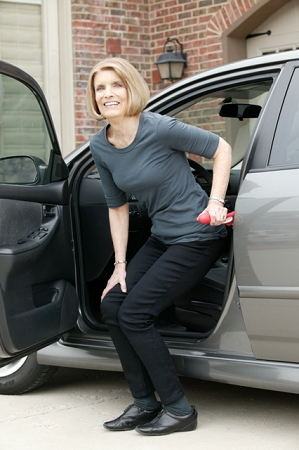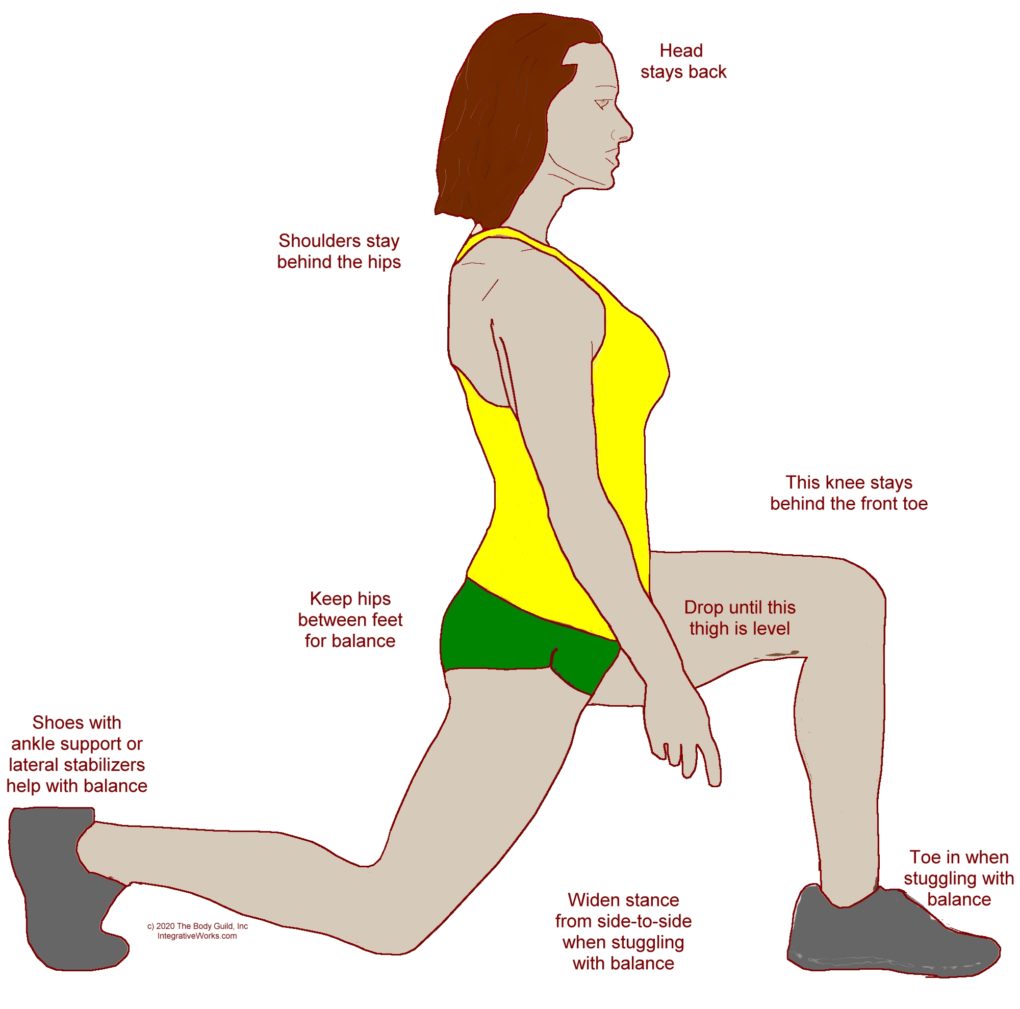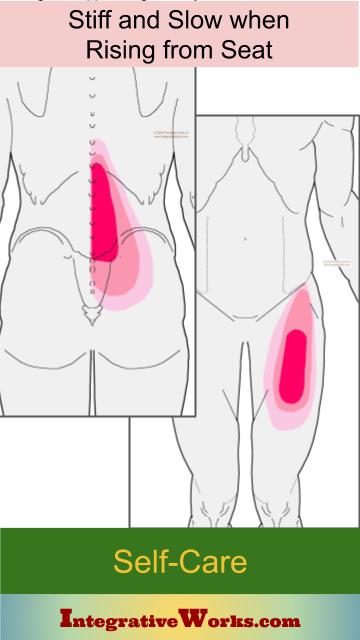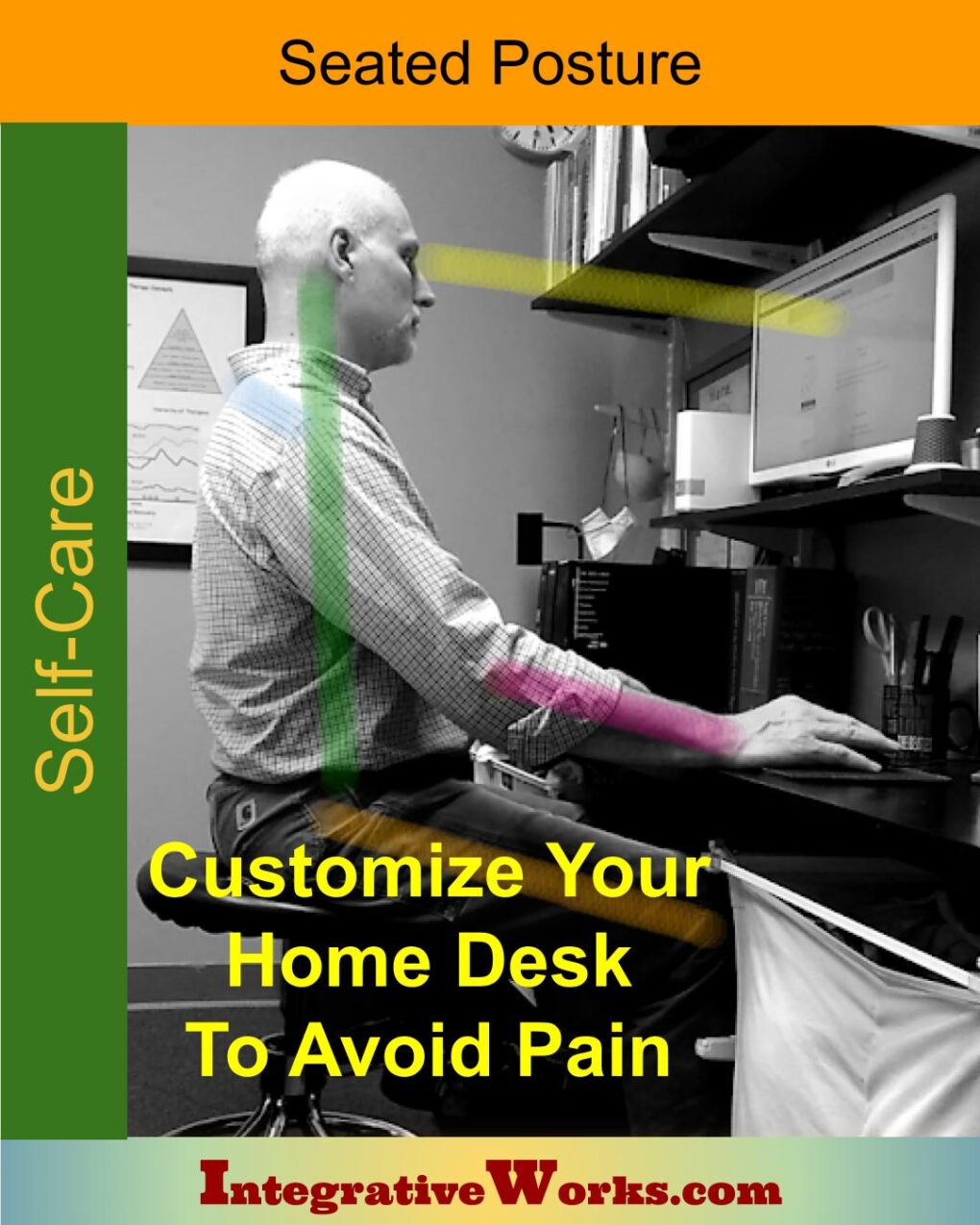Client Description
Table of Contents
- Activities to Avoid or Change
- For Temporary Relief
- Stretches and Exercises for Longer-Lasting Relief
- Yoga Corner
Here, you will find self-care for relief when you are painfully stiff and slow when rising from a seat. If you’d like to read more about how people describe this pain or aggravate the condition, look at this other post.
Activities To Avoid or Change:

Help Yourself
Use the arms of the chair to help push yourself out of the chair and keep your head back. As your head drops forward, you will find that your back feels more fragile and painful.
Raise Your Seat
Avoid sitting with your knees above your hips. Having your knees flexed at more than 90 degrees will make it harder to get up. Sitting low also curves your low back so that the braid of muscles that support the curve of your spine (multifidi) weaken. This position makes it harder and more painful to get up. Look at the post below to set up a seating arrangement that works best for you.
Move
Many therapists suggest setting a timer that gets you out of your chair every 20 minutes or so. This really helps your neck and low back from getting “stove up.”
For Temporary Relief:
For relief on the go
or getting out of bed.
These topical patches offer relief from this stiffness. They boost your energy during the day. This stiffness and pain can unknowingly rob you of energy. I’ve used these when traveling on vacation tours, and it makes the day much better. I keep them on hand for days of moving or yard work. I’ll place one on my wife, kids, or friends and they have renewed energy. When you put one on before bed, getting out of bed is much easier.
Put them where it is in this picture on the box. Feel for your ribs and hips in the back and center this patch in that area.
They are available. here on Amazon.
Improve the ergonomics
at your home or office.
This post offers some great ideas for actively sitting without support or sitting with supports that help you avoid pain and fatigue. There are also suggestions about a few useful accessories.
These self-care activities, like over-the-counter drugs, are not intended to replace appropriate medical attention. If you have concerns about these self-care activities, get help from a professional. Use these suggestions and strategies with discretion and at your own risk. See your doctor when your pain is severe, persistent, or not responding to these simple suggestions.
Stretches and Exercises for Longer-Lasting Relief:
Gentle Opener
This Upward-Dog position is a gentle way to release the abdominals. As a result, it establishes a supportive curve in the low back. She does a great job of lifting moderately without pressing the hips into the mat. Pressing hips into the mat may create pressure on the discs and sharp pain in the low back.
Rectus femoris often contributes to this problem but is not strongly stretched in this pose.
Kneeling Hip-Flexor Stretch
This kneeling stretch for hip flexors is a classic because it allows you to target the problem and gives you lots of control.
Some people have a problem with knee pain and use a pillow, but the knee pain goes away once the hip flexor muscles, especially the rectus femoris, opens up. Go for gentle repetition and avoid forceful thrusting. This is a particularly useful exercise to implement ice-and-stretch.
Great Middle Choice
If your knee bothers you too much in the kneeling stretch, bridges are a good choice. Do them using the guidelines from Active Isolated Stretching or ice-and-stretch. They help build the opposing muscles in the low back and hamstrings.
Start out lifting just until you get a little tension. She has placed her hands under her feet, which is an impressive stretch on the quads. It is a worthy goal. Most people start by grabbing the cuff of their pants or the back of their shoes.
Hold each repetition for about 2 seconds and drop all the way back down. Do 10-20 twice a day or more. This will build the opposing muscles. Lift until your hips are arched above level, just a bit higher than her.
These will be easier if you do 10 reps of the supine twist on each side before your bridges.
Core work to balance the abdominals and especially exercises the pull in the abdomen while twisting help. Digestive issues can directly impact the balance between the iliopsoas and abdominals. If you notice that the problem is worse when your digestion is disturbed, you should work with a professional to improve your diet.
For the more active body
Walking lunges, when done properly, do a great job of opening the abdomen, lengthening psoas and building the opposing erector muscles.

Walking Lunges
- Step forward so the front foot is in front of the knee and the back knee is behind your hips.
- Keep your shoulders back over your hips.
- Lower your torso until the front is level.
- Keep your knee behind your toes on the front leg.
- Widen your stance, turn your front toe in a tiny bit, and focus on keeping your hips between your feet if you are unstable.
- Step forward while minimizing how much your head and front shin lean forward.
- Do 6-10 reps on each leg.
I’d love your feedback on how this works for you and any suggestions you might have.
Email me at integrativeworks@gmail.com.
Yoga Corner
Once you get the hip flexor muscles open with poses like Upward Dog, Cobra, and basic bridges, you can isolate hip flexor muscles with poses like the pigeon. In this particular photo, the practitioner has her trunk upright with her pelvis buried in the mat to create an intense stretch on the hip flexors. Look how the back leg comes off the floor a bit for extra stretch.
Support Integrative Works to
stay independent
and produce great content.
You can subscribe to our community on Patreon. You will get links to free content and access to exclusive content not seen on this site. In addition, we will be posting anatomy illustrations, treatment notes, and sections from our manuals not found on this site. Thank you so much for being so supportive.
Cranio Cradle Cup
This mug has classic, colorful illustrations of the craniosacral system and vault hold #3. It makes a great gift and conversation piece.
Tony Preston has a practice in Atlanta, Georgia, where he sees clients. He has written materials and instructed classes since the mid-90s. This includes anatomy, trigger points, cranial, and neuromuscular.
Question? Comment? Typo?
integrativeworks@gmail.com
Follow us on Instagram

*This site is undergoing significant changes. We are reformatting and expanding the posts to make them easier to read. The result will also be more accessible and include more patterns with better self-care. Meanwhile, there may be formatting, content presentation, and readability inconsistencies. Until we get older posts updated, please excuse our mess.








